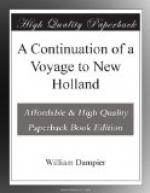When the sea was smooth by the land-winds we sent our boats ashore for water; who, in a few turns, filled all our casks.
The land here is low, swampy and woody; the mould is a dark grey, friable earth. Two rivers came out within a bow-shot of each other, just opposite to the place where we rode: one comes right down out of the country; and the other from the south, running along by the shore, not musket-shot from the seaside. The northernmost river is biggest, and out of it we filled our water; our boats went in and out at any time of tide. In some places the land is overflown with fresh water, at full sea. The land hereabouts is full of trees unknown to us, but none of them very large or high; the woods yield many wild fruits and berries, such as I never saw elsewhere. We met with no land animals.
Strange fowls.
The fowls we found were pigeons, parrots, cockadores, and a great number of small birds unknown to me. One of the master’s mates killed 2 fowls as big as crows; of a black colour, excepting that the tails were all white. Their necks were pretty long, one of which was of a saffron-colour, the other black. They had very large bills much like a ram’s horn; their legs were strong and short, and their claws like a pigeon’s; their wings of an ordinary length: yet they make a great noise when they fly, which they do very heavily. They feed on berries, and perch on the highest trees. Their flesh is sweet; I saw some of the same species at New Guinea, but nowhere else.
The islands Bonao, Bouro, Misacombi, Pentare, Laubana, and Potoro.
May the 3rd at 6 in the morning we weighed, intending to pass between Bonao and Ceram; but presently after we got under sail we saw a pretty large proa coming about the north-west point of Ceram. Wherefore I stood to the north to speak with her, putting aboard our ensign. She, seeing us coming that way, went into a small creek and skulked behind a point a while: at last discovering her again I sent my boat to speak with her; but the proa rowed away and would not come nigh it. After this, finding I could not pass between Bonao and Ceram as I purposed, I steered away to the north of it.
This Bonao is a small island lying about 4 leagues from the north-west point of Ceram. I was informed by the Dutch sloop before mentioned that, notwithstanding its smallness, it has one fine river, and that the Dutch are there settled. Whether there be any natives on it or not I know not, nor what its produce is. They further said that the Ceramers were their mortal enemies; yet that they were settled on the westermost point of Ceram in spite of the natives.
The next day as we approached the island Bouro there came off from it a very fragrant scent, much like that from King William’s Island; and we found so strong a current setting to the westward that we could scarce stem it. We plied to get to the southward, intending to pass between Bouro and Keelang.




